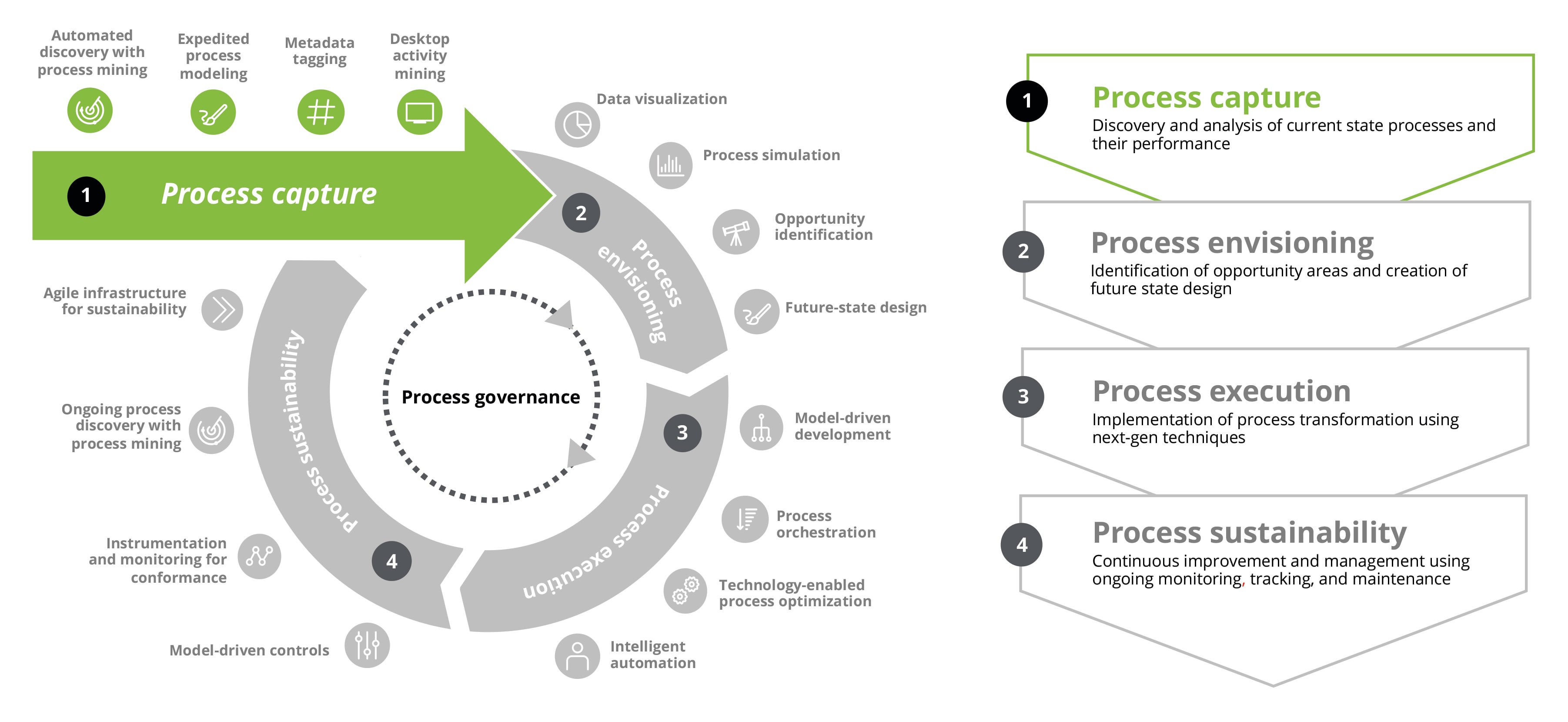A look under the hood of next-generation process capture has been saved

Perspectives
A look under the hood of next-generation process capture
COO Agenda
In an earlier blog, we introduced Process Bionics, a fresh take on process transformation that emphasizes rapid identification and resolution of process breakdowns. Now let’s take a look at how to get started with Process Bionics. The first step? Process capture, or identifying the root causes of process breakdowns so you can figure out what to do about them.
Explore content
- Common challenges with process capture
- Rethinking the traditional methods
- Next-generation techniques
- Drawing up plans for the future
- Get in touch
Common challenges with process capture
Process capture is a critical part of a transformation effort—you can’t fix a process if you don’t know what’s causing it to break down.
But many organizations struggle with process capture. Doing it manually can take a long time and be hard to reprise for future projects. What’s more, the connections between functional process flows aren’t always obvious from a manual perspective. Neither is it necessarily clear who’s performing the tasks, what technologies they use, and how they execute handoffs.
Although automated tools exist, the static processes that conventional solutions support can quickly become outdated. There’s also the possibility that their built-in process flows will go ignored by the broader organization.
Rethinking the traditional methods
Process Bionics takes a next-generation approach to process capture (see figure 1). It involves unpacking the current state to find process breakdowns, using data-driven techniques and advanced technologies where possible (more on that later). Along the way, process breakdowns are sized up by impact in order to prioritize improvement opportunities. With that information, collaborative teams can rapidly design alternative blueprints of the new process, using scenario simulations to quantify the value of potential changes.
Figure 1. Process Bionics: A new approach to process transformation

Next-generation process capture is important in cases where you need faster data provisioning and transparency from one end of a process to the other. The approach is relentlessly focused on finding ways to eliminate, simplify, standardize, and automate processes in order to realize efficiency gains. It also lays the groundwork for change—not only where innovation is concerned, but also in people’s mindset and behavior.
Next-generation techniques
When it comes to process capture, the first thing you need to decide is what type of process capture technique is best suited for the task: process mining or process mapping (also known as process modeling).
Process mining
Process mining enhances traditional process capture with electronic discovery and forensic technology. In other words, it uses digital footprints to track and reconstruct processes via the data that flows through existing systems. Specific tasks can even be tracked to the desktop level using desktop activity mining.
For instance, an oil and gas company we worked with needed to improve its global cash management and customer payment experience. Process mining helped to pinpoint the breakdowns in invoicing and account receivables that were negatively affecting the customer experience. The company discovered more than $500 million in working capital improvement opportunities as a result of this data-driven approach. With that information, the company was able to slash invoice turnaround and, within two years, realize $188 million of the identified improvements.
Process mapping
Process mining can be a highly effective approach if your organization has good, reliable data and if the process in question is automated (even if multiple systems are involved). But what if some of the process is manual, or data is hard to find? That’s where process mapping comes in—live, collaborative mapping to align with and document a single source of truth, enhanced with simulators and analytics for assessing changes to existing processes. This type of process mapping supports organizations’ efforts to capture an accurate view of the current state and achieve effective collaboration even without dependable data to pull from.
Consider the large retailer that sought to build out processes for 10 international markets. They needed to know where functional or technical gaps might exist in those markets, but its existing processes in the United States, which they were using as a baseline, were fragmented and not entirely automated, which made them difficult to track. Rather than rely on workshops and other offline approaches, we applied next-generation process mapping to map 88 processes in just two weeks, highlighting gaps along the way.
Comparing the two techniques
The advantage of process mining is that it’s both quantifiable and objective—there’s no need to rely on someone’s perception of how long it takes to complete a step. All you need is a clear object to track, plus decent-quality data and timestamps to mark the object’s passage through existing systems.
The advantage of next-generation process mapping is that it can provide a holistic view of process flows across manual and digital tasks. It also offers many of the forward-looking attributes of process mining, like sophisticated design modeling and ongoing process review to surface trends and issues early.
Both techniques should apply industry and sector knowledge to single out high-value processes and optimize them with leading practices, automation, and data-driven insights. And, ultimately, both can accelerate a range of business benefits (see figure 2).
Figure 2. Business value through next-generation process transformation

Drawing up plans for the future
In this blog, we looked under the hood of process capture, the first critical step in a process transformation effort. Process Bionics takes a next-generation approach to process capture that makes extensive use of data, technology, and agile collaboration. The aim is to identify the root cause of process breakdowns and develop solutions for them so that the business can benefit as quickly as possible. In our next blog, we’ll look at Process Bionics in action so you can get a sense of how this approach works with detailed, real-world examples.
The impact of Process Bionics on operations
Article 1: A fresh take on process transformation: What every COO should know
Article 2: A look under the hood of next-generation process capture
Article 3: Process Bionics: Process transformation in action
Get in touch
 |
Courtney Thayer Principal Center for Process Bionics |
 |
Alison Roy Managing Director Center for Process Bionics |
|
 |
Daniel Csoka Specialist Leader Center for Process Bionics |
Dinesh Kalluri Managing Director Center for Process Bionics |
||
| Monica Monica Senior Manager Center for Process Bionics |
Recommendations
How COOs can promote health equity
COO Agenda
Welcome to the COO Agenda
Sharing perspectives and insight on operational excellence practices chief operating officers are leading today


